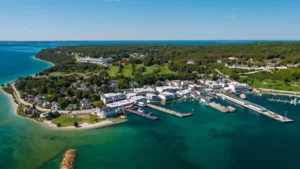Nestled in Michigan—a state renowned for its automotive industry—Mackinac Island offers a quiet retreat where cars are prohibited and horse-drawn carriages are a common sight.

Overview of Mackinac Island
- Mackinac Island is both a city and an island situated in northern Michigan, USA.
- It lies at the northeastern edge of Lake Huron, close to where it connects with Lake Michigan, two of the Great Lakes of North America.
- The island spans roughly 4.35 square miles in area.
- Surrounded by limestone bluffs, the land gradually rises in elevation on its eastern side, reaching up to 339 feet (103 meters) above lake level.
Historical Background
- The Anishinaabek people were the island’s original inhabitants before the arrival of French settlers in the 1600s.
- During the 1700s, the British took control, followed by American governance shortly afterward.
Attractions and Preservation
- Most of the island is part of Mackinac Island State Park, which features forest trails, scenic lookouts, and the well-known Arch Rock limestone formation.
- The island maintains a historic feel from the 18th and 19th centuries—cars are banned, with transportation limited to bicycles, carriages, and walking.
- Key historic sites include the restored Fort Mackinac, the Beaumont Memorial (honoring Army surgeon William Beaumont and his work on digestion), and the Stuart House, once home to an agent of the American Fur Company.




